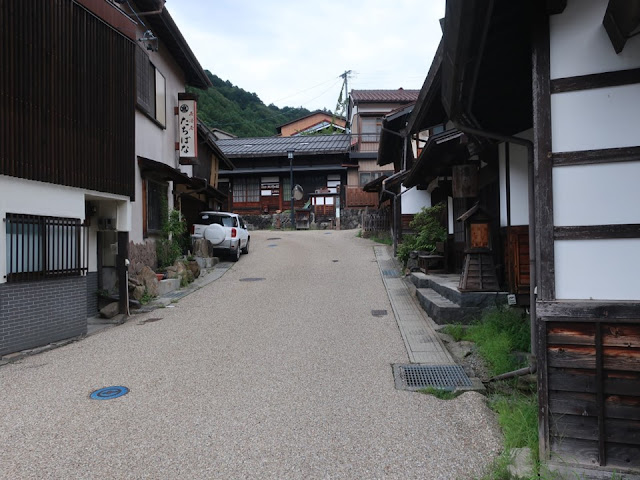Kiso-Fukushima was a post-town on Nakasendou highway which linked Edo (old name of Tokyo) and Kyoto. It is in Nagano prefecture of central Japan. Kiso-Fukushima is a center of “Kiso” region at Kiso Valley; there were eleven post-towns in Kiso. Mountains approach the town; therefore, it is a high-density housing area. Its major industry has been forestry.
The Festival Museum shows us the
enthusiastic festival in summer. Kiso people
explode their energy at the festival.
尾張藩の代官所と関所が置かれた木曽地方の中心地・福島は、木曽川沿いで山が迫った町です。林業の町です。そこに、多くの家がひしめいています。
まつり会館では、神輿を転がすという荒々しい夏祭りが紹介されています。人々のエネルギーを感じますね。
Kiso-Fukushima town、木曽福島
The town is between mountains. Three-story houses were built along Kiso River; those are called “cliff houses”. People have gathered and have lived there. They have managed to live in a narrow land.
山に挟まれた木曽福島。木曽川に沿って、崖家作りといわれる三階建ての家が並びます。木曽福島は人が集まる町、狭い土地で何とか暮らしてきたのですね。
The three-story cliff houses look two-story building from the street.
三階建てですが、通りからは二階建てに見える家々です。
Residents take care of swallows. What gentle towners they are!
燕に気を配るなんて、やさしい町ですね。
The banner says “This fishing spot is for children only. Kiso River fishermen's cooperative”. The river is one of tributaries of Kiso River which is the seventh longest one in Japan (229 km).
子供専用の釣り場もあります。木曽川の支流です。
The view of Fukushima post-town. The zone is called “Ue-no-dan (upper district)”.
中八沢橋からみた福島宿の古い街並み、上の段(うえのだん)に入りました。
There is a watering place on the right. The museum is on the far-left side.
右下は用水。山が近いです。突き当たり手前の左側にまつり会館があります。
Festival Museum、まつり会館
The museum is behind the small shrine.
清明社の奥が「まつり会館」です。
There is a portable shrine at the center of the exhibition room. It is made every year, so it’s new.
展示室中央には、お神輿があります。新しいですが、ここのお神輿は毎年、造り替えるのです。
The portable shrine is paraded at the 22nd and the 23rd of July in the annual festival of Suimu Shrine. On the second day, locals carry the portable shrine, throw it on the ground and roll it. What a rude practice it is! The legend says, “The deity is happy to roll. Because two locals rescued it and rolled downslope from the mountain while going to the town.” An old local told me, “It is said the festival originated in Hida Takayama”.
Movie of the festival in 2022 (with English subtitle):https://www.youtube.com/watch?v=hlt41BXRmAw (People start rolling the portable shrine at 6 minutes.)
7/22、23の水無神社例大祭では、二日目の夕方から、神輿を「宗助」「幸助」の掛け声とともに地面に投げ落とし、横に縦にころがす荒っぽい祭りです。転がすことで、神様が喜んでくれます。宗助と幸助が山から転がりながら神様を救ったといわれています。地元のおじさんによると飛騨高山から伝わったようです。
2022年の水無神社例大祭動画:https://www.youtube.com/watch?v=hlt41BXRmAw
みこしまくりは、6分から。
The festival was much more enthusiastic than nowadays in around 1960. It continues more than four hundred years.
昭和(30年代初め頃)の熱気が凄い。400年続く祭りです・
It’s a long-term festival. At the beginning, a Shinto priest holds a ritual before cutting trees, which are material of a portable shrine.
祭りの始まり。神事を行い、木を切り出して、神輿を作ります。
The carpenters plane a piece of wood for the portable shrine. They use traditional tools “Chouna”.
ちょうなを使った古風な削り方です。
The red curtain in behind is set at the side of the festive float. It is so luxurious! It was worth for local wealthy people to spend money on making it, I think.
奥の赤色の生地は、例祭に出る山車(1852年製造)の幕です。豪華ですね。お金もかかってそうで町人の意気込みを感じます。
The curtain is displayed together with the model and the photo of the float.
豪華な幕は、山車の模型や写真と一緒に飾られています。
During the bon dance in summer above, Kiso folk song (Kiso-bushi) is played. It is one of the most famous folk songs among Japanese. People cover their head and cheeks with towel; it was really old fashion. Btw, a mayor made the song famous; there is a trendsetter behind a popular song.
盆踊りについても展示されています。「木曽のなかのりさん~」で有名な木曽節も歌い踊ります。ほっかぶりが古風ですね。ところで、木曽節を全国に広めた広報マン(大正時代の町長さん)がいました。仕掛け人はいるものですねえ。
I left the museum and restarted walking. The corner was built to prevent enemy from invading the town.
会館を出て、防御のためという鍵の手を通って、北へ向かいます。
The house is narrow in width. It is a feature of town houses. The alley beside the house is named "Uma (horse) Yado (inn) alley".
家の間口は狭いです(鍵の手で分岐する馬宿小路)。
The old Nakasendou highway leads to the site of the check point. I had a lunch at the restaurant “Tori-kagi” beside the road. It was established in 1890.
旧中山道は、関所跡へと登っていきます。道沿いの鳥鍵(右下、1890年創業)さんでランチをいただきました。
How do you like the lunch? It consists of mountain foods and cost ¥1600.
山里御膳 1600円でした。
Reference website 参考サイト: https://www.go-nagano.net/topics_detail6/id=5485
(in Japanese)
Visited in August, 2023
Previous post (neighboring post-town in the
north): Miyanokoshi
post-town、宮ノ越宿(中山道)
Next post (museum in the same town): Kiso-Fukushima checkpoint museum、福島関所資料館





















Comments
Post a Comment